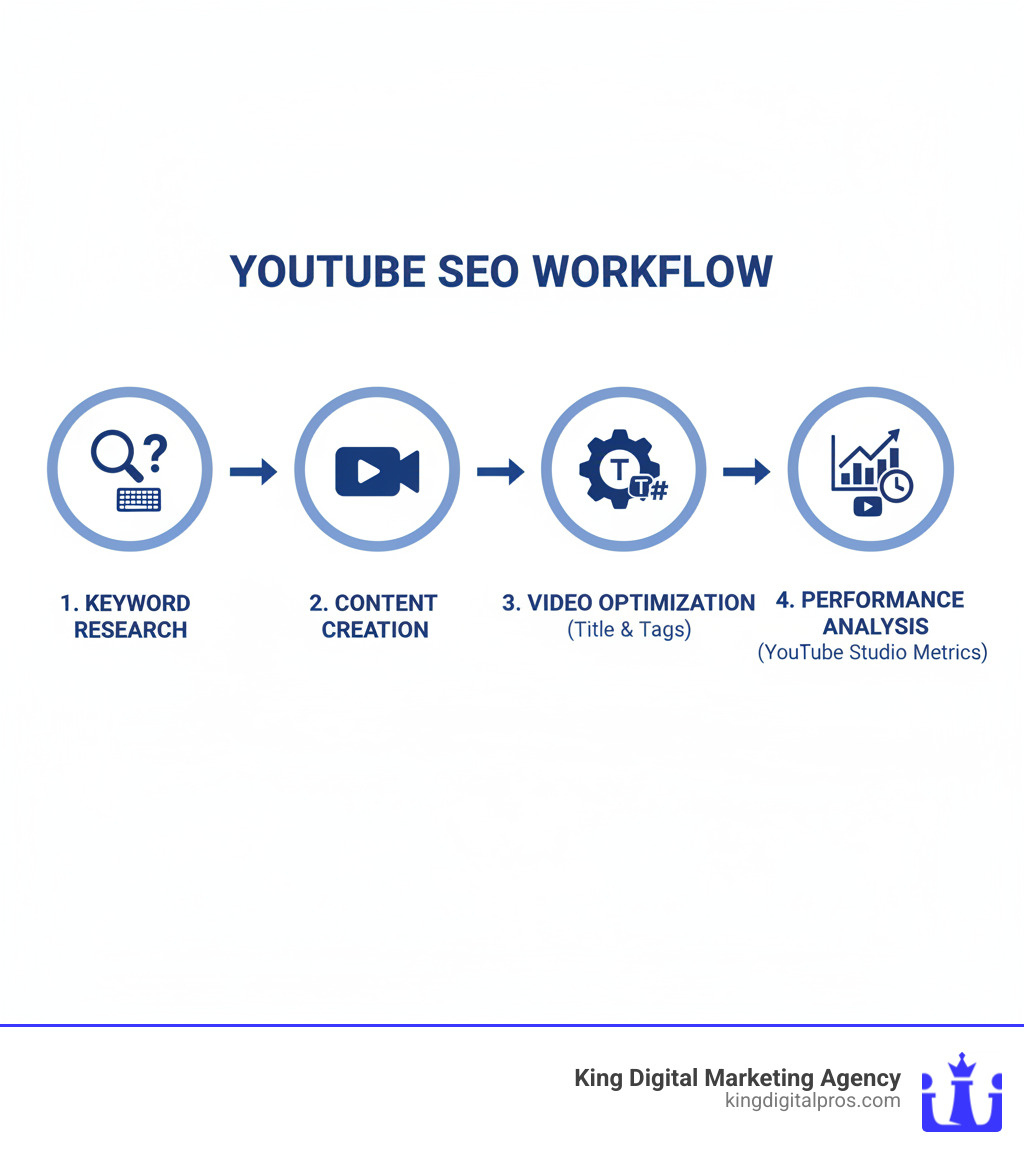How to find youtube keyword competition score and seo 10x Boost
Why Understanding YouTube Keyword Competition Matters for Your Business
YouTube is the world’s second-largest search engine, and when customers search for solutions, your videos should be there to answer them. But without understanding keyword competition, your content can easily get lost. Learning how to find YouTube keyword competition score and SEO metrics is key to standing out.
Competition scores (typically 1-100) measure how hard it is to rank for a keyword, considering the number of competing videos and their channel authority. SEO tools simplify this with “low,” “medium,” or “high” ratings, helping you find opportunities. Since around 40% of desktop search results feature video, strong YouTube SEO also boosts your visibility on Google.
Here’s how to find these crucial metrics:
- Use YouTube Studio’s Research tab to find what your audience is searching for.
- Manually analyze search results by checking the view counts, age, and channel size of top videos.
- Leverage SEO tools (like TubeBuddy or vidIQ) for search volume and competition scores.
- Find the “sweet spot” of medium search volume with low competition.
I’m Bernadette King, founder of King Digital. I help small businesses use targeted video strategies to turn visibility into growth, especially in crowded local markets.

Understanding YouTube Keyword Competition and Its Importance
Have you ever uploaded a great video only to see it get minimal views? The problem often lies in targeting keywords that are too competitive. This is where understanding keyword competition scores and keyword difficulty becomes essential for getting your videos seen.
For local businesses in New Mexico, from Albuquerque to Taos, mastering this concept can turn your channel into a customer-generating machine by working with the YouTube algorithm, not against it.
What is a YouTube Keyword Competition Score?
A YouTube keyword competition score is a difficulty rating for a search term. Most tools use a 1-100 scale or simple “low,” “medium,” and “high” labels. This score is calculated based on several factors:
- Channel Authority: Are you competing against established creators with millions of subscribers?
- Engagement Metrics: Top videos often have high likes, comments, and watch time, making it harder for new content to break through.
- Video Quality: The production value of ranking videos sets the standard you must meet or exceed.
For example, “how to lose weight” is a highly competitive keyword. But a more specific term like “best hiking trails in Los Alamos for beginners” offers a much clearer path to rank for a local business.
Why Competition Analysis is Crucial for YouTube SEO
Analyzing keyword competition provides a strategic advantage by revealing where you can actually win. It helps you spot content gaps-topics people are searching for that lack quality video answers. According to YouTube, viewers actively seek solutions, and being the first to provide a great one establishes your authority.
This analysis is the foundation of smart audience targeting and effective resource allocation. Instead of wasting effort on saturated topics, you can focus on terms where you can achieve results and Improve Search Ranking. Since video appears in about 40% of Google search results, your YouTube SEO efforts have a dual benefit.
At King Digital, we apply this strategic thinking to all our Services: YouTube SEO. Understanding competition isn’t about intimidation; it’s about being smart and finding the lane where your business can shine.
How to Find YouTube Keyword Competition Score and SEO Metrics
Finding keyword competition data doesn’t require a huge budget. You can gather powerful insights using a combination of free and paid methods.

Using YouTube’s Built-in Research Features
Start with YouTube’s free tools. The YouTube search bar’s autocomplete suggestions show you what real users are searching for. For example, typing “best coffee” might suggest “best coffee shops in Albuquerque.”
The real gem is the Research tab in YouTube Studio. As explained in YouTube’s official guide, this feature shows what your viewers are searching for and highlights “content gaps”-searches with few or low-quality results. This is a goldmine for new video ideas that directly meet audience demand.
Manual SERP Analysis for how to find youtube keyword competition score and seo
Next, manually investigate the search engine results page (SERP) for your target keywords. A quick “eyeball test” of the top 5-10 videos gives you context that numbers alone can’t. Look for:
- View Counts: Are they in the millions or a more achievable few thousand?
- Video Age: Do old videos dominate, or is there room for fresh content?
- Channel Size: Are the top spots held by massive channels, or are smaller creators ranking?
- Optimization Quality: Do titles, descriptions, and thumbnails look professional and keyword-focused?
If you see smaller channels ranking with modest view counts, it’s a great sign that you have a chance to compete.
Leveraging Third-Party SEO Tools
Dedicated SEO tools like TubeBuddy and vidIQ take your research to the next level. They provide crucial data points that help you quickly assess keywords:
- Search Volume: An estimate of monthly searches for a term.
- Competition Score: A numerical score (e.g., 1-100) or a simple “low/medium/high” rating of ranking difficulty.
- Trend Data: Is interest in the keyword growing or declining? You can also use Google Trends filtered for YouTube to see this.
- Related Keywords: These tools generate hundreds of long-tail and related keyword ideas, saving you hours of brainstorming.
By combining YouTube’s native features, manual analysis, and third-party data, you can build a complete picture of your keyword opportunities.
Interpreting the Data: Search Volume vs. Competition
Gathering data is one thing; making sense of it is another. The key to effective YouTube SEO is balancing search volume (how many people are searching) with competition (how hard it is to rank). The goal is to find keywords with enough search interest to be worthwhile but not so much competition that your video gets buried.

High, Medium, and Low Competition Levels Explained
- High-Competition Keywords: These are broad terms (e.g., “video editing tutorial”) with massive search volume, dominated by large, established channels. Ranking potential for new or small channels is extremely low.
- Medium-Competition Keywords: These terms (e.g., “beginner acoustic guitar lessons”) have good search volume and a mix of large and growing channels. With quality content and solid optimization, ranking is achievable.
- Low-Competition Keywords: These are often specific, long-tail phrases (e.g., “best gluten-free pizza Cedar Crest NM”) with lower search volume but highly targeted intent. The ranking potential is high, even for new channels, and the traffic is often more valuable.
The “Sweet Spot”: Balancing Search Volume and Ranking Difficulty
The sweet spot for most growing channels and businesses is medium search volume (1,000-5,000 monthly searches) combined with low difficulty ratings. These keywords deliver several key advantages:
- Sufficient Demand: You know there’s an audience actively looking for your content.
- Targeted Traffic: Viewers searching for specific phrases are often more engaged and closer to making a decision.
- Higher Conversion Rates: Answering a specific need leads to more loyal viewers and potential customers.
- Achievable Rankings: With less competition, your videos can reach the first page of search results faster, building momentum for your channel.
As research from Backlinko suggests, successful videos often target these more specific keywords. Focusing on this sweet spot maximizes your chances of being found by an engaged audience and driving real growth for your business.
Strategies for Optimizing Your Videos Based on Competition
Once you’ve identified your target keywords, it’s time to tailor your content strategy. The approach for a low-competition keyword should be different from a highly competitive one. Our [Services: SEO Services] are built on this principle of strategic optimization.
Targeting Low-Competition vs. High-Competition Keywords
For low-competition keywords, your goal is to become the definitive resource. Since there’s less noise, you can win by creating the most comprehensive and helpful video on that specific topic. This is a niche down strategy. Consistently targeting related low-competition terms helps you build topical authority, making it easier for YouTube to trust and rank your future content.
For high-competition keywords, a direct approach is unlikely to work for smaller channels. Instead, you need to be more creative:
- Create “10x” Content: Your video must be significantly better-in production, depth, or presentation-than what currently ranks. As Backlinko’s research confirms, quality and engagement are critical ranking factors.
- Leverage a Unique Angle: Instead of “YouTube SEO,” target “YouTube SEO for local service businesses.” This carves out a sub-niche where you can stand out.
- Collaborate: Partnering with larger channels can expose your content to an established audience, giving you a valuable boost.
On-Page SEO Best Practices for how to find youtube keyword competition score and seo
Regardless of competition, solid on-page optimization is non-negotiable. This tells YouTube exactly what your video is about.
- Title: Place your primary keyword near the beginning. Keep it under 60 characters and make it compelling.
- Description: Write at least 200 words. Include your primary keyword in the first few sentences and sprinkle it naturally throughout. Add related keywords and a clear call-to-action.
- Tags and Hashtags: Use your primary keyword, variations, and related terms as tags. Add 2-3 relevant hashtags in your description for categorization.
- Video Chapters: Add video chapters with keyword-rich titles in your description. This improves user experience and can help chapters appear in Google search results.
- Custom Thumbnail: Create a high-quality, eye-catching thumbnail that accurately represents your video. This is crucial for your click-through rate.
- Call-to-Action (CTA): Encourage viewers to like, comment, subscribe, or visit your website. Engagement signals to YouTube that your content is valuable.
Frequently Asked Questions about YouTube Keyword Competition
Let’s address some common questions about how to find YouTube keyword competition score and SEO.
How many keywords should I target per video?
Focus on quality over quantity. Center your video around one or two primary keywords that perfectly describe your topic. These should appear in your title and early in your description.
Then, support these with three to five secondary or semantic keywords (related phrases and synonyms) throughout your description. This provides context for the algorithm without “keyword stuffing,” which can harm your rankings. Write naturally, as if explaining the video to a friend.
What is the difference between keyword difficulty and keyword competition on YouTube?
While often used interchangeably, there’s a subtle difference. Keyword competition generally refers to the volume of videos targeting a keyword. Keyword difficulty is typically a more sophisticated score (e.g., 1-100) calculated by SEO tools. This score considers not just the volume of content but also the authority of competing channels, engagement metrics, and optimization quality. As noted in Semrush’s guide, difficulty scores offer a more data-driven prediction of your ranking chances.
How do I know if my YouTube keywords are working?
YouTube Studio Analytics provides the answers. Check these key areas:
- Traffic Sources: In Analytics > Reach, look at “YouTube Search.” If it’s a significant and growing source of views (ideally 20%+), your keywords are effective.
- Impressions and Click-Through Rate (CTR): A high number of impressions for your target terms combined with a strong CTR (above 4-5%) means your video is visible and compelling.
- Audience Retention: If viewers who find your video via search watch a large portion of it, this signals relevance to YouTube and boosts your ranking.
Monitor these metrics over time. YouTube SEO is a long-term strategy, and consistent effort will yield results.
Conclusion
Mastering how to find YouTube keyword competition score and SEO metrics is the key to changing your channel from a passion project into a powerful marketing tool. It’s about replacing guesswork with a data-driven strategy.
By using YouTube’s Research tab, conducting manual SERP analysis, and leveraging SEO tools, you can identify the sweet spot: keywords with enough search volume to matter but low enough competition to win. This is especially crucial for local businesses in areas like Albuquerque, as it connects you directly with customers searching for your services.
Strategic content planning means creating the right videos. When you optimize your titles, descriptions, chapters, and thumbnails, each video becomes a lasting asset that drives growth. At King Digital Marketing Agency, we apply this same precision to YouTube that we use to help businesses manage their Google Business Profiles and dominate local search.
The path is clear: research keywords, create exceptional content for achievable terms, optimize every detail, and monitor your analytics. This consistent effort will open up your channel’s true potential.
Unlock your channel’s potential with expert YouTube SEO services


